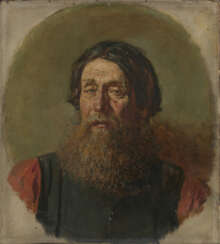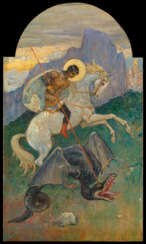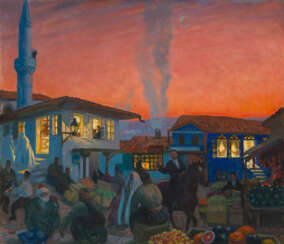vasily petrov



Vasily Grigorevich Perov (Russian: Василий Григорьевич Перов) was a celebrated Russian artist, renowned for his profound contributions to the world of painting. His body of work, characterized by its keen observation and poignant reflection on social issues, established him as a pivotal figure in the realm of 19th-century Russian culture. Perov's specialization in genre painting, alongside his ventures into portraiture and religious themes, showcased not only his versatility but also his deep empathy for the human condition.
Perov's artistry is distinguished by its vivid realism and emotional depth, qualities that marked a departure from the idealized narratives prevalent in the art of his time. His paintings often depicted the stark realities of everyday life, serving as a voice for the marginalized and overlooked sectors of society. This commitment to realism, combined with a masterful command of light and shadow, imbued his works with a powerful sense of immediacy and relevance.
Among his most notable works are "The Last Tavern at the City Gates," "The Arrival of a Governess in a Merchant's House," and "Troika. Apprentices Fetch Water." These paintings, along with others, can be found in prestigious museums and galleries, reflecting Perov's enduring legacy in the pantheon of Russian art. His ability to capture the essence of his subjects with both compassion and critical insight has left an indelible mark on the culture of art and painting.
For collectors and experts in art and antiques, the exploration of Vasily Perov's oeuvre offers a unique window into the socio-cultural landscape of 19th-century Russia. His works not only provide aesthetic pleasure but also invite reflection on the universal themes of human dignity, injustice, and the complexity of social dynamics. To stay informed about new product sales and auction events related to Vasily Grigorevich Perov, sign up for updates. This subscription is a gateway to the rich history and continuing relevance of Perov's artistry, offering exclusive insights into opportunities to own a piece of this illustrious legacy.


Mikhail Vasilyevich Nesterov (Russian: Михаи́л Васи́льевич Не́стеров), a distinguished Russian artist, was renowned for his unique contributions to the realms of painting and art, epitomizing the spiritual and cultural ethos of his era. Born into the vibrant milieu of pre-revolutionary Russia, Nesterov carved a niche for himself with his profound spiritual themes and innovative artistic techniques. His work, deeply rooted in Russian Orthodox traditions, reflects a meticulous blend of realism and symbolism, capturing the essence of Russian culture and spirituality.
Nesterov's artistry is celebrated for its ethereal quality, marked by a distinctive use of color and light to evoke a sense of divine presence. Among his most acclaimed works is the series on St. Sergius of Radonezh, a revered Russian saint, which not only showcases his technical prowess but also his ability to weave spiritual narratives into visual art. These pieces, housed in prestigious museums and galleries, continue to captivate art enthusiasts and collectors worldwide.
His legacy extends beyond his paintings, influencing generations of artists and imbuing Russian culture and art with a profound spiritual dimension. Nesterov's ability to transcend the mundane through his art renders his work timeless, making it a subject of study and admiration among experts in art and antiques.
For collectors and connoisseurs keen on exploring the rich tapestry of Russian art, Nesterov's oeuvre offers a window into the soul of Russia. We invite you to sign up for updates on new product sales and auction events related to Mikhail Vasilyevich Nesterov, ensuring you stay informed about opportunities to own a piece of this legendary artist's legacy. This subscription is your gateway to the world of art and culture, tailored specifically for those who appreciate the profound beauty and spiritual depth of Nesterov's work.


Alexander Vasilyevich Kuprin (Russian: Алекса́ндр Васи́льевич Купри́н) was a Russian painter and educator, renowned for his contribution to the "Jack of Diamonds" group and his profound influence on Soviet art. Born in Borisoglebsk, Voronezh region, in 1880, Kuprin's early life was steeped in the creative atmosphere provided by his family, moving to Voronezh in 1893. His educational journey through various art schools culminated at the Moscow School of Painting, Sculpture, and Architecture, where he was under the tutelage of Abram Arkhipov and Konstantin Korovin.
Kuprin's art evolved significantly over time. Initially inspired by French painting and Cézanne, his early works were marked by Cubist influences, characterized by a geometric simplification of forms. As one of the founding members of the Knave of Diamonds, he was at the forefront of avant-garde movements in Russia. However, his style underwent a transformation towards realism in the 1920s, influenced by his experiences in Nizhny Novgorod and later travels to Crimea. This period marked a departure from avant-garde to a focus on industrial landscapes and the natural beauty of the Crimean peninsula.
His significant works, often reflecting his fascination with the interplay of light, shadow, and form, are held in high esteem, with notable pieces like "Still Life With Blue Tray" and "The Beasal’skaia Valley" housed in the Tret’iakov Gallery. Kuprin's commitment to education saw him teaching at various institutions, including the Moscow textile Institute and the Moscow Higher Art and Industrial School, influencing generations of artists.
Alexander Vasilyevich Kuprin's legacy is not only in the beauty he captured on canvas but also in the minds he shaped through his teaching. His works, a testament to the evolution of Russian art through turbulent times, continue to inspire and captivate.
Collectors and experts in art and antiques can find a deeper appreciation for Kuprin's work by exploring his contributions to the Russian avant-garde and his influence on Soviet art aesthetics. For those interested in staying updated on sales and auction events related to Alexander Vasilyevich Kuprin, signing up for updates is highly recommended. This subscription will provide exclusive insights into the availability of his works, ensuring enthusiasts don't miss the opportunity to own a piece of Russian art history.


Aristarkh Vasilyevich Lentulov (Russian: Аристарх Васильевич Лентулов) was a prominent figure in Russian avant-garde art, celebrated for his distinctive use of color and innovative approach to Cubism. Born in Nizhneye Lomovo, Penza oblast, Russia, in 1882, Lentulov's early years were spent in a religious family, setting a foundation that would influence his rich and vibrant artistic style. His education at the art institutes in Penza and Kiev, followed by his studies under Dmitry Kardovsky in St. Petersburg, prepared Lentulov for a groundbreaking artistic career.
Lentulov's artistic journey took a significant turn when he moved to Paris in the winter of 1911. There, he was exposed to the works of leading French Cubists at the Académie de la Palette, including Henri Le Fauconnier. This period marked Lentulov's deep dive into Cubism and Orphism, influenced by his interactions with avant-garde artists such as Jean Metzinger, Albert Gleizes, and Fernand Léger. Upon his return to Russia, he became one of the founders of the Jack of Diamonds, a group that exhibited artists with "leftist tendencies" and embraced foreign, mostly French Cubists.
Lentulov's style uniquely combined the spatial concepts of Cubism with the vibrant colors of Fauvism, drawing on Russian folk art to create compositions that were both innovative and deeply rooted in Russian culture. His works, characterized by their luminous color and dynamic composition, played a significant role in the development of Russian Futurism and Cubo-Futurism. Notably, his involvement in theatrical projects, including set designs for the Kamerny Theatre and the Bolshoi Theatre, highlighted his versatility and creative genius.
Aristarkh Lentulov's legacy is preserved in his contributions to the avant-garde movement, and his works continue to be celebrated for their bold experimentation and vibrant expression. His paintings, such as "Saint Basil's Cathedral" and "The Belfry of Ivan the Great," are held in high esteem, showcasing his ability to capture the essence of Russian architecture and culture through a modernist lens.
Art enthusiasts and collectors recognize Lentulov as a pivotal figure in the evolution of modern Russian art. His innovative techniques and bold use of color have cemented his place in art history as a master of Russian avant-garde.
For updates on exhibitions and auction events featuring Aristarkh Vasilyevich Lentulov's work, sign up for our newsletter. Stay informed about the latest sales and opportunities to add a piece of Russian avant-garde history to your collection.
























































